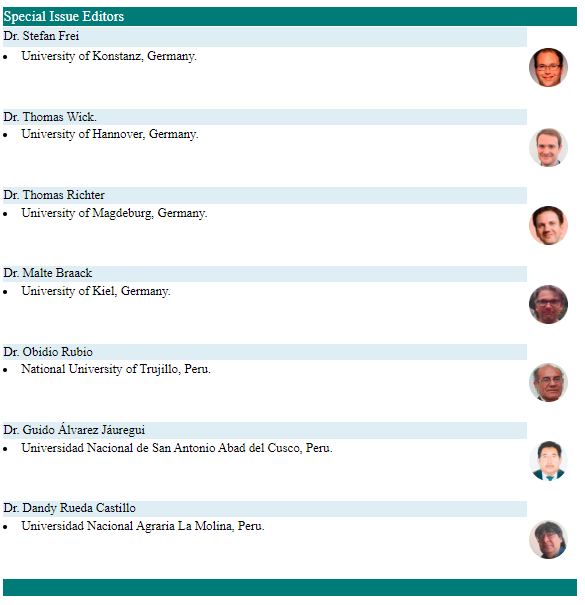Analysis and dynamics of the predator-prey: Toxoplasma Gondii and common influenza with associated costs models
DOI:
https://doi.org/10.17268/sel.mat.2022.02.15Palavras-chave:
Predator-prey, toxoplasma, common influence, RStudioResumo
This work is intended to provide basic information and numerical experimentation of biological models focusing on how computation can be used to generate results via software R. In addition, this work enriches the scientific literature in Spanish that links mathematics and computational biology. It also provides detailed information on the analysis of Predator-prey, Toxoplasma gondii, and Common influency models.
For the development of this article we will speak in the first instance of the dynamics of the predator-prey model. In the last two models, it is solved numerically for a range of values of a given parameter. This in order to show deductions that contribute to a deeper investigation of the data involved, and even to the analysis of a professional specialized in the model.
Referências
Allen LJS. An introduction to stochastic processes with applications to biology. 2.a ed. CRC Press; 2010.
Anderson RM, May RM. Infectious diseases of humans: Dynamics and control, Oxford University Press, 1992.
Beauchemin CA, Handel A. A review of mathematical models of influenza a infections within a host or cell culture: lessons learned and challenges ahead, BMC Public Health, 2011; 11(1).
BJ Coburn BGW, Blower S. Modeling influenza epidemics and pandemics:
insights into the future of swine flu (h1n1), BMC Medicine. 2009; 7(30).
Brauer F. Mathematical epidemiology: Past, present, and future, Infectious Disease Modelling, 2017; 2(2):113-127.
Gardiner C. Stochastic methods: A handbook for the natural and social sciences. Springer; Berlin Heidelberg, 2009.
González-Parra GC, Arenas AJ, Aranda DF, Villanueva RJ, Jódar L. Dynamics of a model of toxoplasmosis disease in human and cat populations. Computers and Mathematics with Applications. 2009; 57(10):1692-1700.
Hethcote H. The mathematics of infectious diseases. SIAM Review, 2000; 42(4):599-653.
Hill DE, Dubey JP. Foodborne parasites. En Y. R. Ortega y C. R. Sterling (Eds.), (cap. Toxoplasma gondii), Springer International Publishing, 2005.
McVernon J, McCaaw CT, Mathews JD. Model answers or trivial pursuits? The role of mathematical models in influenza pandemic preparedness planning. Influenza and Other Respiratory Viruses, 2007, 1(2), 43-54.
Kelting EK. Toxoplasma gondii: A mathematical model of its transfer between cats and the environment, SIAM Undergraduate Research Online, 2018, 11.
Koelle K, Cobey S, Grenfell B, Pascual M. Epochal evolution shapes the phylodynamics of interpandemic influenza a (H3N2) in humans, Science, 2006, 314(5807):1898-1903.
Soetaert K, Petzoldt T, Setzer, RW. Solving differential equations in R: Package desolve, J. of Statistical Software. 2010; 33(9):1-25.
Montoya O. Toxoplasmosis. The Lancet, 2004, 363(9425):1965-1976.
Diekmann O, Heesterbeek JAP, Metz, JAJ. On the definition and the computation of the basic reproduction ratio $R_0$ in models for infectious diseases in heterogeneous populations, J. of Math. Biology, 1990, 28(4), 365-382.
Diekmann O, Heesterbeek J. A P, Roberts MG. The construction of next-generation matrices for compartmental epidemic models, Journal of the Royal Society, 2010, 7(47):873-885.
Blanchard P. Differential equations, Cengage Learning, 2012.
Burden RL, Faires JD, Burden AM. Numerical analysis, Cengage Learning, 2016.
Team RC. A language and environment for statistical computing. [Manual de software informático], Vienna, 2018.
Boyce WE, DiPrima RC, Meade BD. Elementary differential equations and boundary value problems, Wiley, 2017.
Feng Z, Velasco-Herandez J. Tapia-Santos B. A mathematical model for coupling withinhost and between-host dynamics in an environmentally-driven infectious disease. Mathematical Biosciences. 2013, 241.
Downloads
Publicado
Como Citar
Edição
Seção
Licença
Copyright (c) 2022 Selecciones Matemáticas

Este trabalho está licenciado sob uma licença Creative Commons Attribution 4.0 International License.
Os autores que publicam nesta revista aceitam as seguintes condições:
Os autores mantêm os direitos autorais e atribuem à revista o direito da primeira publicação, com o trabalho registrado com a licença de atribuição Creative Commons Atribución 4.0 Internacional (CC BY 4.0), que permite que terceiros usem o material publicado sempre que mencionarem a autoria do trabalho e os direitos autorais. Primeira publicação nesta revista.
Os autores podem fazer outros acordos contratuais independentes e adicionais para a distribuição não exclusiva da versão do artigo publicada nesta revista (por exemplo, incluí-la em um repositório institucional ou publicá-la em um livro), desde que afirme claramente que o trabalho Foi publicado nesta revista.
É permitido e recomendado aos autores que publiquem seus trabalhos na Internet (por exemplo, em páginas institucionais ou pessoais) antes e durante o processo de revisão e publicação, pois isso pode levar a trocas produtivas e a uma disseminação maior e mais rápida do trabalho. publicado (Consultar: efeito do acesso aberto).












